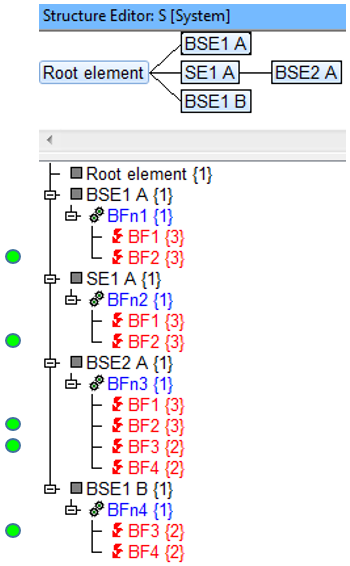Search:
Failure types with inconsistent actions
Explanation:
A search will be performed for failure types with more than one instance, whereby the instances have inconsistent actions (detection or preventive). The order of actions and their grouping in revision states and action groups is not important
Note:
- Types are IQ-objects that are recorded in Catalogs and carry information that is the same for all instances of the type.
- Instances of IQ-objects are created when IQ-objects are selected from the Catalogs and reused elsewhere in the IQ-Software.
Example:
Abbreviations
- ASIL = Automotive safety integrity level
- BF = Base failure of a base function
- BFn = Base function of a base structure element
- BSE = Base structure element
- Cl Prc = Classification for process characteristic
- Cl Prd = Classification for product characteristic
- Cl Req = Classification for requirement
- CM = Control method
- DA = Detection action
- DC = Diagnostic coverage
- DSCF = Dangerous safety critical failure
- Er Det = Error detection
- Er Resp = Error response
- F = Failure
- FIT = Failure in time
- Fn = Function
- FSM = Functional safety management
- IE = Inspection equipment
- LF = Latent fault
- LFM = Latent fault metric
- OC = Operating condition
- PA = Preventive action
- PE = Process element
- PFH = Probability of failure per Hour
- PMHF = Probabilistic metric for random hardware failures
- PrcC = Process characteristic
- PrdC = Product characteristic
- QM = Quality method
- QR = Quality rule
- Req = Requirement
- RMR = Risk Matrix Ranking
- RP = Reaction plan
- SE = Structure element
- SE ErDet = Structure element for error detections
- SE ErResp = Structure element for error responses
- SFF = Safe failure fraction
- SG = Safety Goal
- SIL = Safety integrity level
- SM = Organisational-SE for “safety mechanisms”
- SPF = Single point fault
- SPFM = Single point fault metric
- TF = Top failure of a top function
- TFn = Top function at root element
- TS = Test sample

- The failures BF1 and BF2 are anchored at the three different functions BFn1, BFn2 and BFn3. They, therefore, occur three times in the structure, which can be identified with the number inside the curly braces: {3}. The display option “Instance count” must be active.
- The failures BF3 and BF4 are each anchored at the functions BFn3 and BFn4 and therefore have two instances ({2}).
- With the display option “Actions” active in the structure list, it is possible to see which functions are anchored at which failures.
For the sake of clarity, the functions are not displayed in the following image. The arrows are intended to make it easier to find the same failure types.

Search result: ![]()
By analyzing the structure list, it is possible to see that BB2 and BF3 both have instances with differing actions.
This Quality Rule will deliver 5 hits, all 3 instances of BF2 and both instances of BF3.